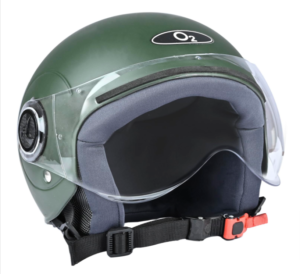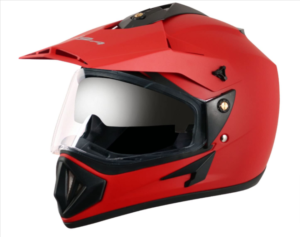Motorcycling brings a sense of freedom and exhilaration, unlike any other form of travel or sport. Yet, the thrill comes with inherent risks that necessitate protective measures for every rider. This comprehensive guide outlines the essential safety gear that forms a protective shield, ensuring every ride is as safe as it is exhilarating.
1. The Backbone of Motorcycle Safety: Helmets
Choosing the right helmet is crucial, as it protects the most vital part of your body, your head. Let’s break down the essentials of finding the perfect helmet:
Choosing the Right Helmet:
| Sl.No | Photo | Halmet Type | Features | Read More |
|---|---|---|---|---|
| 1 |  | Full-face Helmet | Coverage: These helmets cover the rider’s face and the entire head. Safety: Considered the safest type, they protect the chin and jaw from impact during accidents. Advantages: Optimum protection, shields from rain, wind, and noise Comfort: Available in various options, from low-cost to premium. Note: Some riders may find them suffocating. | Read more |
| 2 |  | Open-face helmet | Coverage: These helmets cover only the head, forehead, and ears. Comfort: Lightweight and suitable for short commutes. Usage: Popular in city traffic and hot weather conditions. Caution: Does not protect the chin and jaw adequately. | Read more |
| 3 |  | Modular Helmet | Features: Combine full-face and open-face designs. Functionality: The chin guard and visor can be flipped up. Protection: Offers similar safety as full-face helmets. Cost: Slightly heavier due to the hinge but more affordable than premium full-face helmets. | Read more |
| 4 |  | Half-shell Helmet | Coverage: Partially covers the head, leaving the face exposed. Use: Common among cruiser riders and urban commuters. Comfort: Lightweight and well-ventilated. Note: Provides limited protection compared to full-face helmets. | Read more |
| 5 |  | Off-Road Helmet | Purpose: Designed for dirt biking and motocross. Features: Extended chin bar, sun visor, and ventilation. Safety: Protects against debris and impacts during off-road riding. | Read more |
| 6 |  | Dual-Sport Helmet | Versatility: Suitable for both on-road and off-road riding. Design: Combine the features of full-face and off-road helmets. Benefits: Offers good visibility and ventilation. | Read more |
- Types of Helmets: There’s a variety to choose from; full-face helmets offer the most protection, while modular ones offer convenience with their flip-up visor. The key is to pick one that suits your riding style and offers maximum protection.
- Fit and Comfort: A helmet should fit snugly without causing discomfort. A good fit ensures effective protection. Try different sizes and wear each one for a few minutes to check the fit.

Helmet Safety Standards:
- Understanding the Ratings: DOT, ECE, and Snell ratings are benchmarks of safety standards. Each one has its testing criteria, but essentially, they ensure that the helmet can withstand significant impacts and protect your head.
Maintenance and replacement:
- Taking Care of Your Helmet: Regular cleaning, proper storage, and keeping an eye on its condition are pivotal. A helmet isn’t something you buy and forget; it requires care.
- When to Get a New One: If your helmet has been through an impact or is over 5 years old, it’s time for a replacement. Advances in technology also mean newer models offer better protection.
2. Body Armor: More Than Just a Jacket
Your torso, back, elbows, and knees need protection too, and that’s where body armor comes into play.


Jackets and Pants – The Protective Second Skin:
- Materials Matter: Leather and high-abrasion-resistant textiles offer great protection. Look for gear with CE-rated armor in critical areas for added safety.
- Adapting to Weather: With options like ventilated gear for summer, waterproof gear for rainy days, and insulating layers for the cold, your riding gear can adapt to all seasons.
The Role of Armor:
- Impact Protection: Armor at key points like shoulders, elbows, and backs helps absorb the force from impacts, significantly reducing potential injuries.
Specialized Gear for All Seasons:
- Choosing wisely: Features like removable liners and air vents can make one piece of gear versatile for different weather conditions.
3. Gloves: Guarding the Hands That Steer Your Journey
Hands are often the first point of contact in an accident, so protecting them is a no-brainer.

Material Matters:
- Leather vs. Textile: Leather offers excellent abrasion resistance, while textiles can be more breathable. Some gloves combine both for maximum benefits.
Design Features for Enhanced Safety:
- Protection and Comfort: Look for gloves with reinforced palms, padding, or carbon fiber knuckles. A good pair doesn’t just protect; it also fits well, offering comfort and flexibility.
Fit and Comfort:
- Getting the Right Size: Gloves should allow for easy movement while being snug enough not to slip off in case of a crash.
4. Boots and Foot Protection: The Foundation of a Rider
Your feet and ankles are crucial for operating your motorcycle, meaning they need protection too.

Choosing the Right Boots:
- Features to Look For: Boots should support the ankle, have non-slip soles, and provide protection against impacts and abrasions.
Safety Certifications for Footwear:
- What to Look Out For: Just like helmets, look for boots that meet recognized safety standards. This ensures they’ve been tested for riding scenarios.
Care and Maintenance:
- Lengthening Your Boots’ Life: Regular cleaning and conditioning (for leather boots) can keep them in top condition for years.
5. Eye Protection and Visibility Enhancements
Seeing and being seen is vital for motorcycle safety.

Visors and goggles:
- Choosing Eye Protection: Whether it’s a tinted visor for sunny days or clear goggles for the night, ensure they provide UV protection and are scratch-resistant.
High-Visibility Gear:
- Being Seen: Reflective vests, jackets, and even decals on helmets can make a huge difference in how well other drivers see you.
Auxiliary Lighting:
- Lighting Up: Additional lights can enhance your visibility to others, especially in foggy or low-light conditions.
Conclusion
Riding a motorcycle exposes one to the elements and potential hazards, making it crucial to don the appropriate safety gear. By investing in quality helmets, body armor, gloves, boots, and visibility enhancements, riders can significantly mitigate the risks associated with motorcycling. Embracing these protective measures not only ensures a safer ride but also enhances the overall riding experience by instilling confidence and peace of mind.
FAQs
Q: How often should I replace my motorcycle helmet?
A: Most experts recommend replacing your helmet every 3 to 5 years, depending on usage, wear and tear, and advances in helmet technology.
Q: Is it necessary to wear all this gear even for short trips?
A: Yes, accidents can happen at any time, regardless of the journey’s length. It’s important to wear all your gear, all the time.
Q: Can reflective gear make a difference at night?
A: Absolutely. Reflective gear can significantly increase your visibility to other drivers, especially during the night or in poor weather conditions.
Q: How do I care for my leather motorcycle gear?
A: Regular cleaning with a damp cloth and occasional treatment with a leather conditioner will help maintain the durability and appearance of your leather gear.
By embracing these safety measures and equipping themselves with the essential gear, riders can enjoy the freedom of the open road with peace of mind, knowing they are protected.